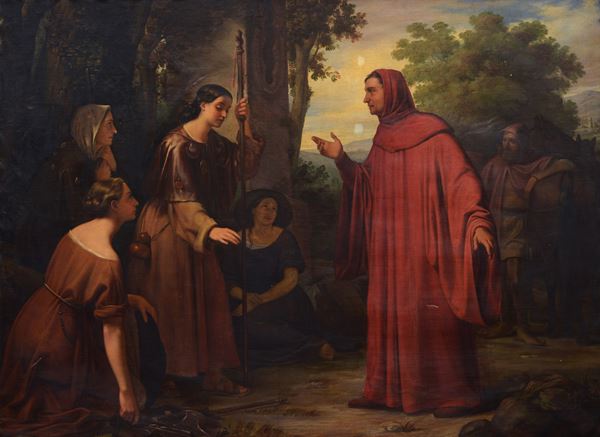190
Cesare Masini (Bologna , 1812 - 1891)
Petrarca traveling to Monterivo, 1839
Oil painting on canvas
cm. 150x200
Cesare Masini is considered by critics to be the greatest of the Bolognese historical painters of the nineteenth century. With an academic education, he never failed in this initial education, actively using also from a critical theoretical point of view in the defense of early academicism any contamination, romantic or purist (and later naturalist) he was. Awarded several times in the competitions that were regularly held at the Accademia Clementina, in 1833 he won the "small prize" of Curland with a first version of Petrarca, a canvas praised by critics; in 1936 he won the «grand prize» for painting with The meeting of the somms pontiff Leo which, a few years later, in Rome, aroused such admiration that the public force was forced to intervene to disperse the large crowd that gathered in front of it. Masini arrived in the capital in 1839 at the invitation of the Duchess of Sagan, the recognitions continue with the election as a member of the Academy of Virtuosi al Pantheon (Bgo) and the career progresses with the appointment as president and professor of painting of the Academy of fine arts Pietro Vannucci of Perugia, positions he held from 1842 to 1845. And in Perugia, which goes on display in 1845, the large canvas Petrarca on his way to Monterico, of which, according to specialist criticism, until today unfortunately the traces: read what Anna Chiar Fontana writes for the biography entry in the Treccani Encyclopedia (Dizionario Biografico degli Italiani, vol. 71, year 2008): «At the Umbrian Academy today only archival papers relating to his nomination and to the exam topics proposed to the students: unfortunately, no trace of the paintings Petrarca traveling to the Monterivo charterhouse, The defeated Syrians try to save their lives (aB41 and Dalinda liberated by Rinaldo, presented by M. at the Perugian exhibition of 1842 together with Dante the ambassador and with the Death of the Carraresi". The scholar takes up here in full what was complained about in the fact sheet drawn up by Alessandra Borgogelli on the occasion of the exhibition held at the Galleri d'Arte Moderna in Bologna entitled From the Academy to truth, Painting in Balogna before and after TUrity (exhibition catalogue, 1983). The painter's biography then records, in relation to an exhibition held in 1851 in Odessa, the publication of another painting referring to Petrarca, today known to critics as Petrarca in uraggio per S, Giacomo di Compostella, also a canvas - scholars still point out - lost. However, regarding this supposed second painting, it is worth considering the fact that no trip to Santiago de Compostela is recorded in Petrarch's life, while the only episode relating to this topic is his meeting, along the itinerary towards Monterivo, with the pilgrims who go to the Spanish sanctuary, with the largest of whom the poet stays to talk.
Well, the large canvas today in Sardinia is certainly that Petrarca traveling to the Monterivo charterhouse who was thought to be lost: title (exactly Petrarca traveling to Monterivo), signature and date (1839, the year of the transfer to Rome to the Duchess of Sagan) appear on the back of the painting, of beautiful quality and truly considerable dimensions (150 x 200 cm). The work now found represents the poet stopped talking with three women, who conspicuously wear the Pecten jacobeus, or the shell symbol of Saint James, pinned on their clothes: there is therefore no doubt that these are the pilgrims of the episode just mentioned, which he believed he was mistakenly referring to a hypothetical painting Petrarch traveling to San Giacomo di Compostella. Therefore if - as it seems possible to affirm - the canvas depicting this episode of Petrarch's life is only one, and not two, what has been recovered today is the important work which in both cases was considered lost, and which goes to exhibition twice, the first in 1842 in Perugia, the second in 1851 in Odessa. Masini died in Bologna on 20 June 1891. Sources and Bibl.: Around two historical paintings by Professor C. M. of Bologna, representing The death of the Carraresi lords of Padua and Dante Alighieri ambassador to Boniface VIII.., Bologna 1845; S. Lodovici, Historians, theorists and critics of the figurative arts of Italy (from 1800 to 1940), Rome 1946, p. 228; A. Borgogelli, C. M., in The Curlandesi competitions (catal.), edited by R. Grandi, Bologna 1980, pp. 94-96; Id., C. M., in Dall'Accademia al vero. Painting in Bologna before and after the Unification (catal.), edited by R. Grandi, Bologna 1983, pp. 107 s.; G. Tiziani, Three unpublished nineteenth-century paintings by C. M. and Virginio Monti, in Bull. of the Tarquiniense Society of Art and History, 1986, n. 15, pp. 179-184; A. Borgogelli - P. Stivani, Painting in the nineteenth century, in Illustrated History of Bologna. Bologna in the modern age: facts, places, characters, IlI, edited by W. Tega, Bologna 1989, pp. $285., 290; A. Borgogelli, Antonio Puccinelli in Bologna. The years in the Emilian city between misunderstanding and controversy, in 8oo italiano, I (1991), 2, pp. 13-16, 18 s.; Painting in Italy. L'Ottocento, Milan 1991, 1, ad ind.; II, pp. 908 s.; U. Thieme - F. Becker, Kinstlerlexikon, XXIV, p. 205; L. Servolini, Diz. illustrated by Italian engravers.., p. 506. (A.C. Fontana, from the Biographical Dictionary of Italians, vol. 71, year 2008)
€ 25.000,00 / 35.000,00
Estimate
Unsold






